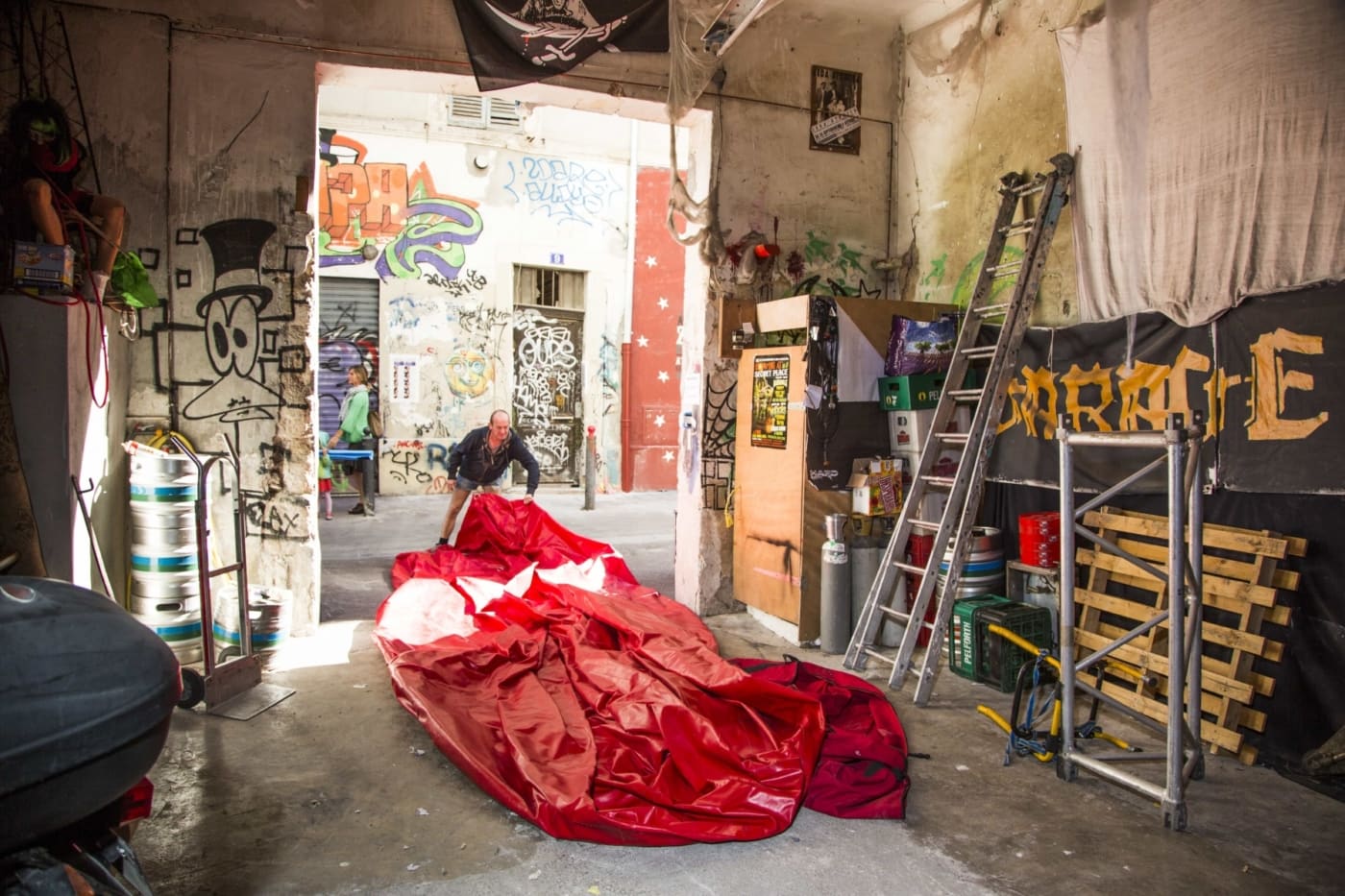So artists write in and ask an artist career question. I might write back. But then where does that time go? It’s gone. So I’m going to start keeping my answers here. This may be of absolutely no use to you. That’s ok. It makes me feel better about it when I do write back, so it’s a real cosmic benefit…
Q. Agapeh: “I am a lighting designer who is trying to make her way into light art. I am trying to pave my own path since I have not attended art school. “
Hello Agapeh,
I don’t know where you are in your career, and I can’t summarize this whole path, but luckily Jerry Saltz already did. So for sure read this and take it seriously, it is about 90% accurate to my experience.
‘Jerry Saltz How To Be an Artist’. If you want a book, get this one, the only one you’ll ever need. It’s written more for gallery artists than festival light artists, but ignore that, it’s super valuable. Jackie Battenfield’s “The Artist’s Guide“
No art school is not really an issue as presumably you already have technical skill in lighting, it’s only an issue as to a tribe, (see above article item #24). But you can go build that without school and eventually having not gone to art school will be a good thing, because everyone around you did go.
You can build a tribe most easily in the way he describes and also art residencies. Though you’ll need some work first to get into them.
Ok one other thing, you mention my story is interesting because “you do projects globally”. You need to be really clear on your motivations. If it’s to travel, then make a living some other way and then travel. This is not a shortcut to that. If you want to make a living as an artist, then global travel is also not something you get right away.
Guess how you get to travel for your first art festival gigs if you get them? You pay. My first city I did illegally and paid my own way, I wrote an article about that somewhere. I also teach an occasional course on how to do this and get paid, but it’s harder to do both.
The key here is to prioritize what it is you are really after. Make a list of the top 5 things in order of importance top down. Then cross out the bottom 4, and just work on the top one until you have it, then get to #2.
Yes I have traveled the world because of my art, but in the beginning, I didn’t travel AND make money. Now I try to travel less because my list changed, I have a family and getting on a plane is time away. Goals change, so just work on what’s important to you now don’t try to predict the future.
On submitting to artist residencies.
Yes rather than submitting ‘day job design work’, you’re better off doing something rough and seemingly ‘unprofessional’ like buying 100 lights at Home Depot, documenting ideas with them over a weekend, and returning them all on Monday.
Whatever your version of that would be, while this kind of thing seems a crazy way to start, it is more important to see your ideas and the way you think materialized and documented, then unrelated finished products. BTW, I have a friend who has a well known international gallery career- and he once returned an entire installation to Home Depot, $5,000 worth of stuff!
On PR for art projects.
Well, this might sound dated but I think it applies, Instagram and Facebook and Pinterest are not enough (but you still have to do them). It’s the difference between finding fans for your work, and finding presenters for your work. Your goal is an opportunity to make your work.
I got launched by doing illegal installs in Barcelona. So your Lisbon plans sound good!
I begged a favor from a curator writer I knew to write a fantastic press release (post-event) and packaged that with best images. You have to do this. I then took that release and sent it to some magazines I thought might be interested, and one took it and basically reprinted the release with the photos from Barcelona; it was Sculpture Magazine.
This got me my first paid gig in Australia. Turns out the curator had wanted to book me, but I wasn’t ‘in print’ so her boss said no, then the magazine article (that my friend wrote as a favor) came out, and I got booked. Don’t underestimate how much presenters need to see you written about and thus validated in their eyes.
You can use an online PR wire service (like prnewswire) to help distribute, but you still need it to be really well written and basically ready to use with eye-catching images, and you do need send that personally to your targets like blogs and magazines. For lighting work the photos are often sexy and you’ll have tons of possibilities, but you are looking for two kinds of places 1. Big online audience like designbloom that crave new images constantly and all the others like them 2. The target audience of more curatorial focus.
PR is a tough thing for a lot of artists, but the artwork is not enough, you have to be the one to get it in front of people who can help you. Have a good plan before you go to Lisbon, PR is best done via relationships so start that part early. If you have a friend in PR who knows how to do this, it’s the most valuable favor you can get.
Q. Scott @ the wild Itchy-O regarding a grant budget for Creative Capital
“I wasn’t sure whether to include ticket sales and revenue that would come after as $$ to be raised. Their tips sheets don’t really speak to it and their Performing Arts Project Budget example doesn’t list ticket sales as a source of income so I didn’t either but, ticket sales will be how we pay in order to pull this off…”
Hey Scott,
Good to hear from you again. So on your question, I’d list ticket sales, it’s part of your budget and part of how performing arts groups work. The fact they don’t have it in their example is probably… well I’m betting they fund a lot of performing arts that have no ticket sales right?
Whatever incoming funds you have, investors etc. are important as they show you have enough going for you that people invest/pay etc. The budget isn’t just about numbers, they are going to try to answer a few questions with it. Remember their job isn’t just to pick great projects, its to rule out 98% of them. So don’t give them an easy way to do that to you with the budget.
1. Negative. “Does this proposal have a realistic enough budget they have a clue of how to pull this off”. It’s not about if the numbers are exactly right, but can you demonstrate competency. They want to rule out things that are wildly unrealistic or badly conceived in the budget.
2. Positive. “Does the budget demonstrate the partners are really partners, they have commitments and a solid plan.”
On grand proposal budgets FYI, this might sounds silly but… Pay yourself in the budget, but don’t look like your going to make a dime past that. It’s a small thing, but if you look too financially viable it’s a negative. I was once told by an insider, “well their not going to fund you Kurt, you actually make money.” Amazing but true, the poverty mentality lives on!
Q. Kelley @ the awesomely named cakeweek.com
“I’m a pretty conscientious person, but I don’t necessarily address social issues in my work. Is it worth angling your proposal (shoe-horning was the term I use) to try to fit with the festival’s theme, or should one just move on and look for a better fit?”
Kelly,
I can relate to this. The range of what issues art should be dealing with seems to be contracting at the moment. Everyone wants something fixed and thinks art should do that. But that’s not every artist.
I will frustratingly have two takes on this, but maybe between them you can figure out what is right for you.
The first take is your right; if the distance between your work and the’ theme’ is too great it will be clear and likely not work out for a presenter or committee. Those odds can be long.
However, artistic directors and presenters are human, and they are continually reimagining how something fits, or doesn’t fit, in their concept for a festival. That line is different for every single person, and even within one presenter it’s continuously moving. An experienced festival director, or artistic director, knows a’ theme’ is just an umbrella concept to group and promote a series of works. They might feel they need to be able to explain why a set of artworks is inside a theme, or frankly they might not.
So my take is you shouldn’t rule out themed festivals automatically. Make a judgment about how big the gap is, and if you can create the language to fill it. I’d lean towards festivals with a single ‘decider’ vs a group or committee. A sole artistic director has much greater room for movement. If they want your work, they will discover it fits the theme.
It’s also possible this is more problematic inside the light festival world, as there might be a perception that new works can easily be created on a theme, however crazy that is. I haven’t run into many festivals who care about there theme once the festival starts.
People all want the new, and this can be an issue for some art careers. However, touring is based on repetition, getting really good at whatever the show is. I’ve personally found that repetition to be a great teacher.

